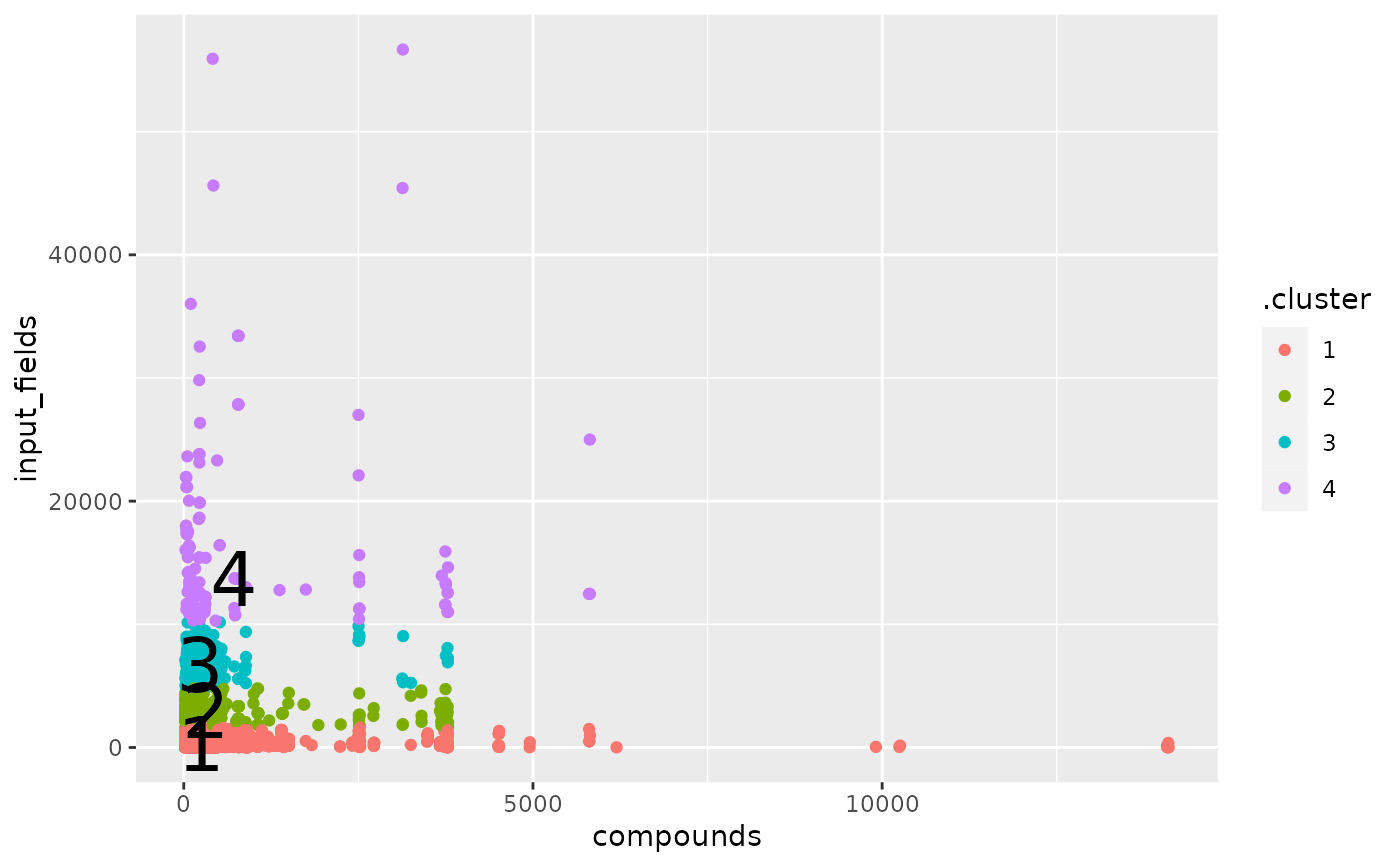Augment 接受模型对象和数据集,并添加有关数据集中每个观察值的信息。最常见的是,这包括 .fitted 列中的预测值、.resid 列中的残差以及 .se.fit 列中拟合值的标准误差。新列始终以 . 前缀开头,以避免覆盖原始数据集中的列。
用户可以通过 data 参数或 newdata 参数传递数据以进行增强。如果用户将数据传递给 data 参数,则它必须正是用于拟合模型对象的数据。将数据集传递给 newdata 以扩充模型拟合期间未使用的数据。这仍然要求至少存在用于拟合模型的所有预测变量列。如果用于拟合模型的原始结果变量未包含在 newdata 中,则输出中不会包含 .resid 列。
根据是否给出 data 或 newdata,增强的行为通常会有所不同。这是因为通常存在与训练观察(例如影响或相关)测量相关的信息,而这些信息对于新观察没有有意义的定义。
为了方便起见,许多增强方法提供默认的 data 参数,以便 augment(fit) 将返回增强的训练数据。在这些情况下,augment 尝试根据模型对象重建原始数据,并取得了不同程度的成功。
增强数据集始终以 tibble::tibble 形式返回,其行数与传递的数据集相同。这意味着传递的数据必须可强制转换为 tibble。如果预测变量将模型作为协变量矩阵的一部分输入,例如当模型公式使用 splines::ns() 、 stats::poly() 或 survival::Surv() 时,它会表示为矩阵列。
我们正在定义适合各种 na.action 参数的模型的行为,但目前不保证数据丢失时的行为。
参数
- x
-
从
cluster::pam()返回的pam对象 - data
-
base::data.frame 或
tibble::tibble()包含用于生成对象x的原始数据。默认为stats::model.frame(x),以便augment(my_fit)返回增强的原始数据。不要将新数据传递给data参数。增强将报告传递给data参数的数据的影响和烹饪距离等信息。这些度量仅针对原始训练数据定义。 - ...
-
附加参数。不曾用过。仅需要匹配通用签名。注意:拼写错误的参数将被吸收到
...中,并被忽略。如果拼写错误的参数有默认值,则将使用默认值。例如,如果您传递conf.lvel = 0.9,所有计算将使用conf.level = 0.95进行。这里有两个异常:
也可以看看
其他 pam 整理器:glance.pam() 、tidy.pam()
例子
# load libraries for models and data
library(dplyr)
library(ggplot2)
library(cluster)
library(modeldata)
data(hpc_data)
x <- hpc_data[, 2:5]
p <- pam(x, k = 4)
# summarize model fit with tidiers + visualization
tidy(p)
#> # A tibble: 4 × 11
#> size max.diss avg.diss diameter separation avg.width cluster compounds
#> <dbl> <dbl> <dbl> <dbl> <dbl> <dbl> <fct> <dbl>
#> 1 3544 13865. 576. 15128. 93.6 0.711 1 242
#> 2 412 3835. 1111. 5704. 93.2 0.398 2 317
#> 3 236 3882. 1317. 5852. 93.2 0.516 3 240
#> 4 139 42999. 5582. 46451. 151. 0.0843 4 724
#> # ℹ 3 more variables: input_fields <dbl>, iterations <dbl>,
#> # num_pending <dbl>
glance(p)
#> # A tibble: 1 × 1
#> avg.silhouette.width
#> <dbl>
#> 1 0.650
augment(p, x)
#> # A tibble: 4,331 × 5
#> compounds input_fields iterations num_pending .cluster
#> <dbl> <dbl> <dbl> <dbl> <fct>
#> 1 997 137 20 0 1
#> 2 97 103 20 0 1
#> 3 101 75 10 0 1
#> 4 93 76 20 0 1
#> 5 100 82 20 0 1
#> 6 100 82 20 0 1
#> 7 105 88 20 0 1
#> 8 98 95 20 0 1
#> 9 101 91 20 0 1
#> 10 95 92 20 0 1
#> # ℹ 4,321 more rows
augment(p, x) %>%
ggplot(aes(compounds, input_fields)) +
geom_point(aes(color = .cluster)) +
geom_text(aes(label = cluster), data = tidy(p), size = 10)

相关用法
- R broom augment.poLCA 使用来自 poLCA 对象的信息增强数据
- R broom augment.polr 使用来自 (n) 个 polr 对象的信息增强数据
- R broom augment.plm 使用来自 plm 对象的信息增强数据
- R broom augment.betamfx 使用来自 betamfx 对象的信息增强数据
- R broom augment.robustbase.glmrob 使用来自 glmrob 对象的信息增强数据
- R broom augment.rlm 使用来自 rlm 对象的信息增强数据
- R broom augment.htest 使用来自(n)个 htest 对象的信息来增强数据
- R broom augment.clm 使用来自 clm 对象的信息增强数据
- R broom augment.speedlm 使用来自 speedlm 对象的信息增强数据
- R broom augment.felm 使用来自 (n) 个 felm 对象的信息来增强数据
- R broom augment.smooth.spline 整理一个(n)smooth.spline对象
- R broom augment.drc 使用来自 a(n) drc 对象的信息增强数据
- R broom augment.decomposed.ts 使用来自 decomposed.ts 对象的信息增强数据
- R broom augment.lm 使用来自 (n) lm 对象的信息增强数据
- R broom augment.rqs 使用来自 (n) 个 rqs 对象的信息来增强数据
- R broom augment.nls 使用来自 nls 对象的信息增强数据
- R broom augment.gam 使用来自 gam 对象的信息增强数据
- R broom augment.fixest 使用来自(n)个最固定对象的信息来增强数据
- R broom augment.survreg 使用来自 survreg 对象的信息增强数据
- R broom augment.rq 使用来自 a(n) rq 对象的信息增强数据
- R broom augment.Mclust 使用来自 Mclust 对象的信息增强数据
- R broom augment.nlrq 整理 a(n) nlrq 对象
- R broom augment.robustbase.lmrob 使用来自 lmrob 对象的信息增强数据
- R broom augment.lmRob 使用来自 lmRob 对象的信息增强数据
- R broom augment.mlogit 使用来自 mlogit 对象的信息增强数据
注:本文由纯净天空筛选整理自等大神的英文原创作品 Augment data with information from a(n) pam object。非经特殊声明,原始代码版权归原作者所有,本译文未经允许或授权,请勿转载或复制。
